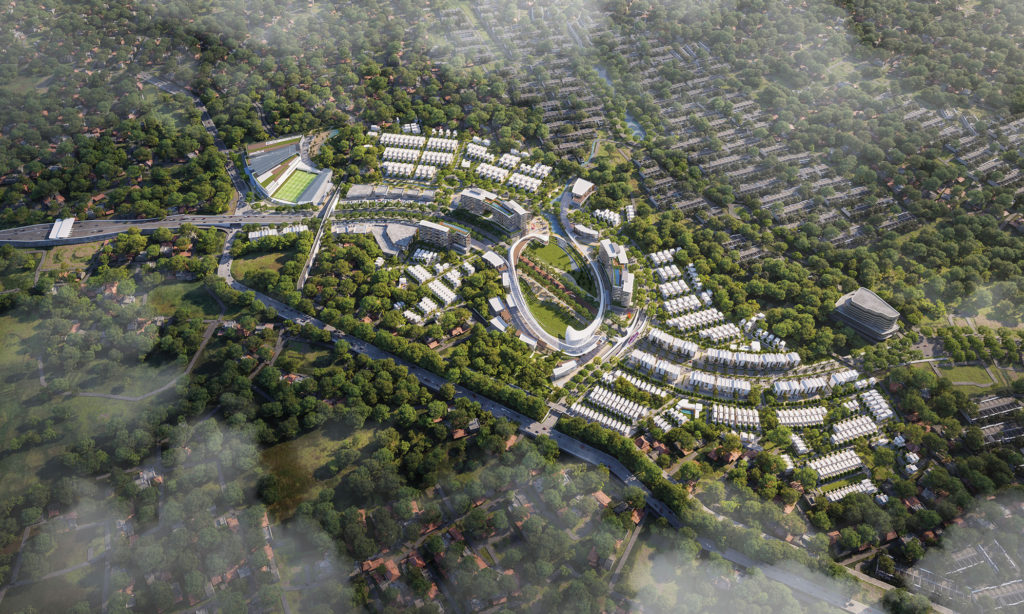District-Level Water Resilience: Bintaro Jaya West District Master Plan
December 6, 2023
In the second half of 2023—reeling from the compound hydrometeorological phenomena of the El Nino climatic pattern, a positive (dry) Indian Ocean Dipole (IOD) phase, the summer equinox and rising global temperatures—many areas in and around the Greater Jakarta region experienced prolonged drought.1 Some experts have forecasted that the dry season in the southern hemisphere may persist well into next year, with rainfall predicted to increase after February 2024.2 Further, the El Nino heat effect is still expected to peak come 2025.3
A paradox encountered in many regions of Indonesia is how drought and flooding seemingly alternate, especially in places without adequate measures to ‘balance’ one another. Despite abundant rainwater during the wet seasons, many settlements have not been equipped with the necessary means to collect water for future use. A water management expert stated that less than one per cent of all residential areas in Indonesia have rainwater catchment systems in place.4
Hence, there is an even stronger impetus for new developments to make good use of water as an essential resource. This entails analysing the existing hydrology and identifying adequate water infrastructures for all seasons.
PLANNING THE PATH OF WATER
One of the greenfield developments that has applied district-level water strategies at the planning phase is the westward expansion of Bintaro Jaya in South Tangerang. The area of Bintaro Jaya itself was first established in 1979 to be a self-sufficient neighbourhood within and adjacent to Jakarta,5 and today it is applying ’15-minute city’ concepts for living, working and entertainment within close proximity.
The Bintaro Jaya West District Master Plan includes landed houses, apartments, mixed-use commercial centres including office space, as well as a recreational centre. At the heart of the district, a publicly accessible green space called The Oval is designed to be an anchor for community activities equipped with eateries, retail, interactive water gardens, amphitheatres and an elevated pedestrian walkway. More notably, The Oval also serves as the district’s water detention feature, also called a dry pond.
Dry ponds are ‘basins’ of land that detain excess stormwater for a short amount of time to help mitigate flood risk. They are usually designed with vegetation that should withstand both dry and wet conditions.6 The sizeable landscape of The Oval is placed in a central and sunken position in the district to collect and store rainwater overflow, relieving inundation during peak rainy periods. The water is then absorbed through a series of bio-wells for long-term groundwater recharge.
This landscape feature is situated in alignment with local hydrological features, including a retention pond in the adjacent district. The planning and urban design team of 10 Design shared: “The existing river and waterway systems have been integrated into the main development’s open space network. The design concept aims to create a unifying open space with natural waterways as a unique character in the west district. By placing the waterways within public parks, it encourages a shared space for all residents, enabling them to interact and foster a sense of community.”
[This is an excerpt. Subscribe to the digital edition or hardcopy to read the complete article.]
PROJECT DATA
Project Name
Bintaro Jaya West District Master Plan
Location
South Tangerang, Banten, Indonesia
Status
Under construction
Completion Date
Planning complete 2023
Site Area
362,000 square metres
Client/Owner
Jaya Real Property
Master Planner; Urban Designer
10 Design
Design Principal
Peter Barrett
Architecture Team
Leonard Kawun; Hafizh Adinugraha; Toy Petchdee; Erwin Setiawan; Octa Wardhana
Images
KOMA; 10 Design
Read more stories from FuturArc 4Q 2023: Water!

Don’t miss out on our ongoing competition—submit your entries for FuturArc Prize 2024: Architecture for Life After … now!

1 https://www.kompasiana.com/pradanaabimantrasoekaryadi2207/6520f89aedff763f2830f3a2/mengatasi-krisis-air-bersih-di-kota-tangerang-selatan; https://www.bidiktangsel.com/info-tangsel/97010327113/18-titik-wilayah-di-tangsel-alami-kekeringan-dan-kesulitan-air-bersih; https://tangseloke.com/2023/10/07/bpbd-tangsel-libatkan-swasta-atasi-bencana-kekeringan/
2 https://www.cnnindonesia.com/teknologi/20230828162423-199-991476/el-nino-menggila-bmkg-ingatkan-ancaman-kekeringan-hingga-november
3 https://www.cnbcindonesia.com/news/20230530093827-4-441677/alert-ramalan-terbaru-ri-panas-mendidih-sampai-tahun-2025
4 https://www.medcom.id/pendidikan/news-pendidikan/nbw0O9xk-pakar-ugm-sebut-ancaman-kekeringan-mesti-diantisipasi-sebelum-masuk-musim-kemarau
5 https://www.bintarojaya.id/about
6 United States National Pollutant Discharge Elimination System (NPDES): Stormwater Best Management Practice—Dry Detention Ponds
To read the complete article, get your hardcopy at our online shop/newsstands/major bookstores; subscribe to FuturArc or download the FuturArc App to read the issues.

